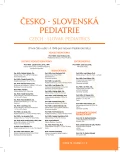Jak přesné je echokardiografické měření otevřené tepenné dučeje?
Authors:
A. Kulkarni 1,2; N. Oswal 1; Z. Slavík 1
Authors‘ workplace:
Department of Paediatrics, Royal Brompton & Harefield NHS Foundation Trust
London, United Kingdom
1; Department of Neonatology, St. George’s Hospital NHS Foundation Trust, London, United Kingdom
2
Published in:
Čes-slov Pediat 2017; 72 (2): 117-120.
Category:
Original Papers
Overview
Cíl studie:
Srovnání měření vnitřního rozměru otevřené tepenné dučeje pomocí echokardiografie a angiografie, považované za zlatý standard, u kojenců a dětí.
Metody:
Retrospektivní analýza dat u dětských pacientů podstupujících katetrizační léčbu otevřené tepenné dučeje v centru dětské kardiologie mezi březnem 2013 a březnem 2014. Měření vnitřního rozměru otevřené tepenné dučeje bylo retrospektivně provedeno na nahraných echokardiografických a angiografických záznamech nezávisle dvakrát dvěma pozorovateli na předem dohodnutém zobrazení.
Výsledky:
Celkem bylo identifikováno 47 pacientů s dostupnými echokardiografickými a angiografickými záznamy dostatečné kvality. Střední věk pacientů byl 7,5 roku (interval 8 měsíců – 15 let) a průměrná hmotnost byla 12,5 kg (standardní odchylka 7,5 kg). Intrapersonální korelační koeficient byl 0,5 (95% interval spolehlivosti 0,25–0,69) a interpersonální korelační koeficient byl 0,45 (95% interval spolehlivosti 0,18–0,65) pro echokardiografická a 0,75 (95% interval spolehlivosti 0,61–0,85) a 0,83 (95% interval spolehlivosti 0,71–0,9) pro angiografická měření. Pearsonův korelační koeficient byl 0,275 a mezitřídní korelační koeficient byl 0,247 mezi echokardiografickými a angiografickými měřeními vnitřního rozměru otevřené tepenné dučeje jedním pozorovatelem potvrzující nízkou korelaci a souhlas. Měření téže otevřené tepenné dučeje jedním pozorovatelem na echokardiografickém a angiografickém záznamu byla statisticky významně odlišná (p <0,0001).
Závěry:
Na základě našich dat nekoreluje měření velikosti otevřené tepenné dučeje z angiografického záznamu, považované za zlatý standard, s měřením z echokardiografického záznamu. Toto zjištění může mít dopad na léčebné postupy založené pouze na echokardiografickém měření otevřené tepenné dučeje.
KLÍČOVÁ SLOVA:
otevřená tepenná dučej, echokardiografie, angiografie, kojenci, děti
Sources
1. Samanek M, Voriskova M. Congenital heart disease among 815,569 children born between 1980 and 1990 and their 15-year survival: a prospective Bohemia survival study. Pediatr Cardiol 1999; 20 (6): 411–417.
2. Carlgren LE. The incidence of congenital heart disease in children born in Gothenburg 1941-1950. Br Heart J 1959; 21 (1): 40–50.
3. Costeloe K, Hennessy E, Gibson AT, et al. The EPICure study: outcomes to discharge from hospital for infants born at the threshold of viability. Pediatrics 2000; 106 (4): 659–671.
4. Van Overmeire B, Smets K, Lecoutere D, et al. A comparison of ibuprofen and indomethacin for closure of patent ductus arteriosus. N Engl J Med 2000; 343 (10): 674–681.
5. Harling S, Hansen-Pupp I, Baigi A, et al. Echocardiographic prediction of patent ductus arteriosus in need of therapeutic intervention. Acta Paediatr 2011; 100 (2): 231–235.
6. Bose CL, Laughon MM. Patent ductus arteriosus: lack of evidence for common treatments. Arch Dis Child Fetal Neonatal Ed 2007; 92 (6): F498–502.
7. Krichenko A, Benson LN, Burrows P, et al. Angiographic classification of the isolated, persistently patent ductus arteriosus and implications for percutaneous catheter occlusion. Am J Cardiol 1989; 63 (12): 877–880.
8. Zonnenberg I, de Waal K. The definition of a haemodynamic significant duct in randomized controlled trials: a systematic literature review. Acta Paediatr 2012; 101 (3): 247–251.
9. Hajjar M. Severity of the ductal shunt: a comparison of different markers. Arch Dis Child Fetal Neonatal Ed 2005; 90 (5): F419–422.
10. Ramos FG, Rosenfeld CR, Roy L, et al. Echocardiographic predictors of symptomatic patent ductus arteriosus in extremely-low-birth-weight preterm neonates. J Perinatol 2010; 30 (8): 535–539.
11. Kluckow M, Evans N. Early echocardiographic prediction of symptomatic patent ductus arteriosus in preterm infants undergoing mechanical ventilation. J Pediatr 1995; 127 (5): 774–779.
12. Chock VY, Punn R, Oza A, et al. Predictors of bronchopulmonary dysplasia or death in premature infants with a patent ductus arteriosus. Pediatr Res 2014; 75 (4): 570–575.
13. Tschuppert S, Doell C, Arlettaz-Mieth R, et al. The effect of ductal diameter on surgical and medical closure of patent ductus arteriosus in preterm neonates: size matters. J Thorac Cardiovasc Surg 2008; 135 (1):78–82.
14. Sellmer A, Bjerre JV, Schmidt MR, et al. Morbidity and mortality in preterm neonates with patent ductus arteriosus on day 3. Arch Dis Child Fetal Neonatal Ed 2013; 98 (6): F505–510.
15. Ko S-M, Yoon YC, Cho K-H, et al. Primary surgical closure should be considered in premature neonates with large patent ductus arteriosus. Korean J Thorac Cardiovasc Surg 2013; 46 (3):178–184.
16. Trefz M, Wilson N, Acton R, et al. Echocardiographic assessment of ductal anatomy in premature infants-lessons for device design. Echocardiography 2010; 27 (5): 575–579.
17. Sahn DJ, Allen HD. Real-time cross-sectional echocardiographic imaging and measurement of the patent ductus arteriosus in infants and children. Circulation 1978; 58 (2): 343–354.
18. Wong JA, Shim D, Khoury PR, et al. Validation of color Doppler measurements of minimum patent ductus arteriosus diameters: significance for coil embolization. Am Heart J 1998; 136 (4):714–717.
19. Saunders AB, Miller MW, Gordon SG, et al. Echocardiographic and angiographic comparison of ductal dimensions in dogs with patent ductus arteriosus. J Vet Intern Med 2007; 21 (6): 68–75.
20. Kluckow M, Jeffery M, Gill A, et al. A randomised placebo-controlled trial of early treatment of the patent ductus arteriosus. Arch Dis Child Fetal Neonatal Ed 2014; 99 (2): F99–104.
21. Oncel MY, Yurttutan S, Erdeve O, et al. Oral paracetamol versus oral ibuprofen in the management of patent ductus arteriosus in preterm infants: a randomized controlled trial. J Pediatr 2014; 164 (3): 510–514.
Labels
Neonatology Paediatrics General practitioner for children and adolescentsArticle was published in
Czech-Slovak Pediatrics

2017 Issue 2
Most read in this issue
- Trombotické mikroangiopatie – hemolyticko-uremické syndromy a trombotická trombocytopenická purpura
- Nefrotický syndrom v dětském věku
- Doporučení Pracovní skupiny dětské nefrologie České pediatrické společnosti pro diagnostiku a léčbu infekcí močových cest u dětí a dorostu
- Neurofibromatóza u 5letého dítěte – diagnóza na základě huhňavosti
